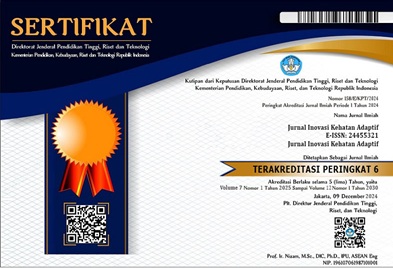EVALUASI KIMIA MEDISINAL FLAVONOID DAUN PEPAYA (CARICA PAPAYA L.) SEBAGAI AGEN ANTIDIABETES MELALUI INHIBISI Α-GLUKOSIDASE
Kata Kunci:
Carica Papaya L., Flavonoid, Α-Glukosidase, Inhibisi, Diabetes MelitusAbstrak
Diabetes melitus tipe 2 (DMT2) merupakan gangguan metabolik yang ditandai dengan hiperglikemia akibat resistensi insulin atau defisiensi sekresi insulin. Daun pepaya (Carica papaya L.) telah digunakan secara tradisional untuk pengobatan diabetes, namun data ilmiah mengenai senyawa aktif dan mekanisme penghambatannya masih terbatas. Penelitian ini bertujuan mengidentifikasi dan mengkuantifikasi senyawa flavonoid dalam ekstrak daun pepaya serta menguji aktivitas penghambatannya terhadap enzim α-glukosidase in vitro. Ekstraksi dilakukan dengan maserasi menggunakan etanol 70%, kemudian senyawa flavonoid diidentifikasi melalui uji fitokimia, KLT, LC-MS/MS, dan HPLC. Hasil menunjukkan adanya tiga flavonoid utama: kuersetin (12,34–12,45 mg/g), kaempferol (8,21–8,76 mg/g), dan mirisetin (5,33–5,67 mg/g). Analisis spektrofotometri UV-Vis menunjukkan total flavonoid sebesar 26,54 ± 0,71 mg/g ekstrak kering. Uji aktivitas penghambatan α-glukosidase menunjukkan bahwa ekstrak bersifat dependen konsentrasi dengan IC<sub>50</sub> 78,24 ± 2,15 μg/mL, lebih rendah dibanding akarbosa (45,67 ± 1,89 μg/mL). Pada konsentrasi 200 μg/mL, ekstrak menghambat 82,15 ± 1,23% aktivitas enzim. Mekanisme inhibisi diduga melalui interaksi hidrogen antara gugus hidroksil flavonoid (terutama kuersetin dan kaempferol) dengan residu Asp215 dan Glu277 pada situs aktif enzim. Hasil ini menunjukkan potensi ekstrak daun pepaya sebagai inhibitor α-glukosidase alami yang lebih aman dibanding akarbosa. Namun, penelitian lebih lanjut mengenai bioavailabilitas dan uji in vivo diperlukan untuk memastikan efektivitasnya sebagai terapi antidiabetes.
Type 2 diabetes mellitus (DMT2) is a metabolic disorder characterized by hyperglycemia due to insulin resistance or insulin secretion deficiency. Papaya leaves (Carica papaya L.) have been traditionally used for the treatment of diabetes, but scientific data on the active compound and its inhibition mechanism are still limited. This study aims to identify and quantify flavonoid compounds in papaya leaf extract and test their inhibiting activity against the enzyme α-glucosidase in vitro. Extraction is carried out by maceration using 70% ethanol, then flavonoid compounds are identified through phytochemical tests, KLT, LC-MS/MS, and HPLC. The results showed the presence of three main flavonoids: quercetin (12.34–12.45 mg/g), kaempferol (8.21–8.76 mg/g), and myrisetin (5.33–5.67 mg/g). UV-Vis spectrophotometric analysis showed a total of flavonoids of 26.54 ± 0.71 mg/g of dry extract. The α-glucosidase inhibitory activity test showed that the extract was concentration-dependent with an IC<sub>50</sub> 78.24 ± 2.15 μg/mL, lower than that of acarbone (45.67 ± 1.89 μg/mL). At a concentration of 200 μg/mL, the extract inhibits 82.15 ± 1.23% of enzyme activity. The inhibition mechanism is thought to be through hydrogen interaction between hydroxyl groups of flavonoids (especially quercetin and kaempferol) with Asp215 and Glu277 residues at the enzyme's active sites. These results show the potential of papaya leaf extract as a natural α-glucosidase inhibitor that is safer than acarbosa. However, further research regarding bioavailability and in vivo tests are needed to ensure its effectiveness as an antidiabetic therapy.





